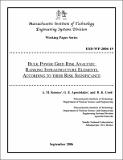| dc.contributor.author | Koonce, A. M. | |
| dc.contributor.author | Apostolakis, George | |
| dc.contributor.author | Cook, B. K. | |
| dc.date.accessioned | 2016-06-02T01:53:03Z | |
| dc.date.available | 2016-06-02T01:53:03Z | |
| dc.date.issued | 2006-09 | |
| dc.identifier.uri | http://hdl.handle.net/1721.1/102807 | |
| dc.description.abstract | Disruptions in the bulk power grid can result in very diverse consequences that include economic, social, physical, and psychological impacts. In addition, power outages do not affect all end-users of the system in the same manner. For these reasons, a risk analysis of bulk power systems requires more than determining the likelihood and magnitude of power outages; it must also include the diverse impacts power outages have on the users of the system.
We propose a methodology for performing a risk analysis on the bulk power system. A power flow simulation model is used to determine the likelihood and extent of power outages when components within the system fail to perform their designed function. The consequences associated with these failures are determined by looking at the type and number of customers affected. Stakeholder input is used to evaluate the relative importance of these consequences. The methodology culminates with a ranking of each system component by its risk significance to the stakeholders. The analysis is performed for failures of infrastructure elements due to both random causes and malevolent acts. | en_US |
| dc.language.iso | en_US | en_US |
| dc.publisher | Massachusetts Institute of Technology. Engineering Systems Division | en_US |
| dc.relation.ispartofseries | ESD Working Papers;ESD-WP-2006-19 | |
| dc.title | Bulk Power Grid Risk Analysis: Ranking Infrastructure Elements According to their Risk Significance | en_US |
| dc.type | Working Paper | en_US |
